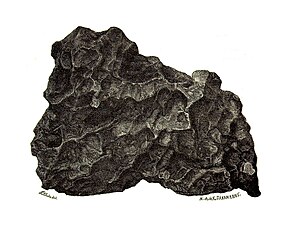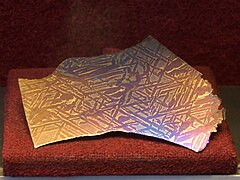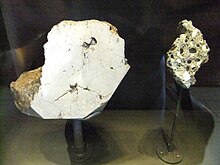

|
Rescuing 2 sources and tagging 0 as dead. #IABot (v1.6)
|
format quote with the template
|
||
| (13 intermediate revisions by 9 users not shown) | |||
| Line 1: | Line 1: | ||
{{Short description|Meteorite that fell in 1751}} |
|||
{{Infobox meteorite |
{{Infobox meteorite |
||
|Name= Hraschina |
|Name= Hraschina |
||
| Line 22: | Line 23: | ||
}} |
}} |
||
'''Hraschina''' is the official name of an [[iron meteorite]] that fell in 1751 near the [[Hrašćina]] |
'''Hraschina''' is the official name of an [[iron meteorite]] that fell in 1751 near the village of [[Hrašćina]] in [[Hrvatsko Zagorje]], [[Croatia]].<ref name=database /><ref name="Horejsi">{{cite journal |url=http://www.meteorite-times.com/Back_Links/2005/October/Accretion_Desk.htm |
||
| |
|journal=Meteorite-Times Magazine |first1=Martin |last1=Horejsi |publisher=Martin Horejsi's Meteorite and Tektite Books |title=Hraschina put the H in Historical! |access-date=July 28, 2011}}</ref> This meteorite is important because it was the first [[meteorite fall|fall]] of an iron meteorite viewed and reported by a significant number of witnesses,<ref name="Report"/> despite its low remaining [[total known weight]].<ref name="Horejsi"/> The Hraschina meteorite also proved that rocks really can "fall from the skies".<ref name="historic">{{cite web |url=http://historicfalls.com/18th-century/hraschina/ |publisher=Historic Falls |title=Hraschina |access-date=July 28, 2011}}</ref> |
||
==History== |
==History== |
||
[[File:Meteorit Hrascina 1751.jpg|thumb|left|upright|Drawing by M. W. Haidinger depicts the fall of the meteorite based on eyewitness accounts.]] |
[[File:Meteorit Hrascina 1751.jpg|thumb|left|upright|Drawing by M. W. Haidinger depicts the fall of the meteorite based on eyewitness accounts.]] |
||
On 26 May 1751, at 18:00, a fireball was seen over Hrašćina and sounds like detonations were heard as far away as [[Varaždin]], giving an estimate of nearly {{convert|1000|sqmi}} of area over which the meteorite's sound was audible.<ref name="Report">{{cite book|url=https://books.google.com/books?id=xes4AAAAMAAJ|title=Report of the Thirty-First Meeting of the British Association for the Advancement of Science|publisher=[[John Murray ( |
On 26 May 1751, at 18:00, a fireball was seen over Hrašćina and sounds like detonations were heard as far away as [[Varaždin]], giving an estimate of nearly {{convert|1000|sqmi}} of area over which the meteorite's sound was audible.<ref name="Report">{{cite book|url=https://books.google.com/books?id=xes4AAAAMAAJ|title=Report of the Thirty-First Meeting of the British Association for the Advancement of Science|publisher=[[John Murray (publishing house)|John Murray]]|location=London|date=1862|pages=[https://books.google.com/books?id=xes4AAAAMAAJ&dq=Hraschina&pg=PA32 32–33]|access-date=August 30, 2011}}</ref> Many people taking their Sunday evening walk witnessed the event. [[Baltazar Adam Krčelić]], a clergyman, historian, and a noted chronicler of daily events, who was spending time in the village of [[Biškupec Zelinski|Biškupec]], recorded the following:<ref name="Krcelic">{{cite journal|url=http://hrcak.srce.hr/file/53160|format=PDF|title=Baltazar Adam Krčelić: Chronicler of Everyday Life|date=June 2001|page=140|last=Marks|first=Ljiljana|journal=Narodna Umjetnost|location=Zagreb|volume=38|issue=1|issn=0547-2504}}</ref> |
||
|
{{quote|"In Biškupec near Varaždin {{interp|...}} an unusual phenomenon like a small cloud was seen — although it was not a cloud — which became paler and paler, produced an explosive sound and then dispersed. In their ignorance, the common folk thought that the heavens had opened.}} |
||
Iron masses of {{convert|39.8|kg}} and {{convert|9|kg}} fell to the east of Hrašćina and were later recovered. The larger mass penetrated {{convert|1.40|m}} into the ground.<ref name="Report"/> But there are reports that it went much deeper.<ref name="historic"/> The smaller mass was split at the place of the fall and partly used by the local villagers for making [[Nail (fastener)|nails]],<ref>{{cite news |url=http://www.vjesnik.hr/Article.aspx?ID=16BE01AC-F0A4-4541-890B-8399402277CB | |
Iron masses of {{convert|39.8|kg}} and {{convert|9|kg}} fell to the east of Hrašćina and were later recovered. The larger mass penetrated {{convert|1.40|m}} into the ground.<ref name="Report"/> But there are reports that it went much deeper.<ref name="historic"/> The smaller mass was split at the place of the fall and partly used by the local villagers for making [[Nail (fastener)|nails]],<ref>{{cite news |url=http://www.vjesnik.hr/Article.aspx?ID=16BE01AC-F0A4-4541-890B-8399402277CB |archive-date=4 April 2012 |archive-url=https://web.archive.org/web/20120404115937/http://www.vjesnik.hr/Article.aspx?ID=16BE01AC-F0A4-4541-890B-8399402277CB |title=Meteoritsko slavlje u Hrašćini |newspaper=[[Vjesnik]] |date=18 May 2011 |language=hr |access-date=23 July 2011 |trans-title=Meteorite celebration in Hrašćina |url-status=dead}}</ref> while the rest of it was split further in [[Bratislava]] and subsequently lost.<ref name="Report"/> |
||
The [[Zagreb]] Catholic chapter sent the meteorites and an official report (the "Protocol of Bishop Klobuczezky and Curate-General Wolfgang Kukuljevic") to the Empress [[Maria Theresa]]. The meteorites were deposited in the Treasury in Vienna and then to the Court museum, now the [[Naturhistorisches Museum Wien]] (Museum of Natural History in Vienna).<ref>Török, J. (1882): A Magyar Birodalom meteoritjei (II. rész). Természettudományi Közlöny, 14, 495–514.</ref> |
The [[Zagreb]] Catholic chapter sent the meteorites and an official report (the "Protocol of Bishop Klobuczezky and Curate-General Wolfgang Kukuljevic") to the Empress [[Maria Theresa]]. The meteorites were deposited in the Treasury in Vienna and then to the Court museum, now the [[Naturhistorisches Museum Wien]] (Museum of Natural History in Vienna).<ref>Török, J. (1882): A Magyar Birodalom meteoritjei (II. rész). Természettudományi Közlöny, 14, 495–514.</ref> |
||
On the basis of the Protocol of Bishop Baron<ref>(Croatian) [http://www.ursulinke.hr/index3.php?pIDm1=11&pIDm2=28&pIDm3=29 Hrvatska provincija uršulinki rimske unije]</ref><ref>(Croatian) [http://www.veritas.com.hr/duhovnost/samostan-sestara-ursulinki-u-varazdinu.php Veritas - Samostan sestara uršulinki u Varaždinu] {{webarchive|url=https://archive. |
On the basis of the Protocol of Bishop Baron<ref>(Croatian) [http://www.ursulinke.hr/index3.php?pIDm1=11&pIDm2=28&pIDm3=29 Hrvatska provincija uršulinki rimske unije]</ref><ref>(Croatian) [http://www.veritas.com.hr/duhovnost/samostan-sestara-ursulinki-u-varazdinu.php Veritas - Samostan sestara uršulinki u Varaždinu] {{webarchive|url=https://archive.today/20130701055710/http://www.veritas.com.hr/duhovnost/samostan-sestara-ursulinki-u-varazdinu.php |date=2013-07-01 }}</ref> [[Franjo Ksaver Klobušicki|Klobuczezky]]<ref>(Croatian) Vlatka Vukelić: [http://bib.irb.hr/datoteka/612814.vlatka_doktorat_2.pdf Povijest sustavnih arheoloških istraživanja u Sisku od 16. stoljeća do 1941. godine], doktorski rad, Zagreb, 2011.</ref> and the fact that these fresh fallen meteorites presented a molten metal crust, in 1794 [[Ernst Chladni]] proposed that meteorites have their origins in outer space.<ref>Chladni, Ernst, ''Über den Ursprung der von Pallas gefundenen und anderer ihr ähnlicher Eisenmassen und über einige damit in Verbindung stehende Naturerscheinungen'' (On the Origin of the Pallas Iron and Others Similar to it, and on Some Associated Natural Phenomena)</ref> Since meteorites were thought to be of volcanic origin, this was a very controversial statement at the time,<ref>{{cite book|author=Williams, Henry Smith|author-link=Henry Smith Williams|title=A history of science|chapter-url=https://books.google.com/books?id=hNEFAAAAIAAJ&pg=PA168|volume=3|date=1904|publisher=[[Harper (publisher)|Harper]]|place=New York|page=168ff|chapter=5|isbn=0-250-40142-8}}</ref> but in |
||
1803 was confirmed by [[Jean Baptiste Biot]] and was then accepted.<ref name="martel"/> |
1803 was confirmed by [[Jean Baptiste Biot]] and was then accepted.<ref name="martel"/> |
||
In 1808 [[Count Alois von Beckh Widmanstätten]] discovered the [[Widmanstätten pattern]]s by heating a slab of this meteorite.<ref name="historic"/><ref name="martel">{{cite web |last1=Martel |first1=L. M. V. |date=May 2009 |title=Better Know a Meteorite Collection: Natural History Museum, Vienna, Austria. Planetary Science Research Discoveries. |publisher=Hawai‘i Institute of Geophysics and Planetology |url=http://www.psrd.hawaii.edu/May09/Meteorites.Vienna.Museum.html | |
In 1808 [[Count Alois von Beckh Widmanstätten]] discovered the [[Widmanstätten pattern]]s by heating a slab of this meteorite.<ref name="historic"/><ref name="martel">{{cite web |last1=Martel |first1=L. M. V. |date=May 2009 |title=Better Know a Meteorite Collection: Natural History Museum, Vienna, Austria. Planetary Science Research Discoveries. |publisher=Hawai‘i Institute of Geophysics and Planetology |url=http://www.psrd.hawaii.edu/May09/Meteorites.Vienna.Museum.html |access-date=July 28, 2011}}</ref><ref>{{cite book|first1=Gerald Joseph Home |last1=McCall|first2=Richard John |last2=Howarth|title=The history of meteoritics and key meteorite collections: fireballs, falls and finds|url=https://books.google.com/books?id=7SvtVoa1W-cC&pg=PA55|access-date=29 July 2011|date=2006|publisher=[[Geological Society]]|isbn=978-1-86239-194-9|pages=55–}}</ref> "Though another scientist, [[G. Thomson]], had also discovered the texture, Widmanstätten's work was recognized by [[Carl Franz Anton Ritter von Schreibers|Carl von Schreibers]] (then Director of the Vienna Natural History Cabinet) and the term Widmanstätten has been used to describe the texture ever since."<ref name="martel"/> |
||
==Composition and classification== |
==Composition and classification== |
||
| Line 43: | Line 44: | ||
Hraschina is an iron meteorite chemical type IID, structural class medium [[octahedrite]]. |
Hraschina is an iron meteorite chemical type IID, structural class medium [[octahedrite]]. |
||
Composition: [[Iron|Fe]] 89%, [[Nickel|Ni]] 10.5%, [[Germanium|Ge]] 89.4 ppm, [[Gallium|Ga]] 74.5 ppm, [[Iridium|Ir]] 13 ppm.<ref>{{cite book |title=Catalogue of meteorites: with special reference to those represented in the collection of the Natural History Museum |place=London, England |volume=1 |url=https://books.google.com/books?id=mkdHJR35Q_8C |
Composition: [[Iron|Fe]] 89%, [[Nickel|Ni]] 10.5%, [[Germanium|Ge]] 89.4 ppm, [[Gallium|Ga]] 74.5 ppm, [[Iridium|Ir]] 13 ppm.<ref>{{cite book |title=Catalogue of meteorites: with special reference to those represented in the collection of the Natural History Museum |place=London, England |volume=1 |url=https://books.google.com/books?id=mkdHJR35Q_8C&pg=PA243 |edition=5 |page=243 |author=Natural History Museum |publisher=[[Cambridge University Press]] |date=2000 |isbn=9780521663038 |access-date=July 28, 2011}}</ref> |
||
==Samples distribution== |
==Samples distribution== |
||
| Line 56: | Line 57: | ||
==External links== |
==External links== |
||
{{Commons category|Hraschina meteorite}} |
{{Commons category|Hraschina meteorite}} |
||
*{{cite web |url=http://historicfalls.com/18th-century/hraschina/ |publisher=Historic Falls |title=Hraschina | |
*{{cite web |url=http://historicfalls.com/18th-century/hraschina/ |publisher=Historic Falls |title=Hraschina |access-date=July 28, 2011}} |
||
*[http://www.nhm-wien.ac.at/en/research/mineralogy__petrography/collections_and_exhibition_halls/the_meteorite_collection The meteorite collection of the Natural History Museum, Vienna] |
*[http://www.nhm-wien.ac.at/en/research/mineralogy__petrography/collections_and_exhibition_halls/the_meteorite_collection The meteorite collection of the Natural History Museum, Vienna] |
||
*[http://dnevnik.hr/vijesti/hrvatska/proslava-obljetnice-pada-metorita-u-hrascini.html Proslava obljetnice pada metorita u Hrašćini] {{ |
*[http://dnevnik.hr/vijesti/hrvatska/proslava-obljetnice-pada-metorita-u-hrascini.html Proslava obljetnice pada metorita u Hrašćini] {{in lang|hr}} |
||
{{Meteorites}} |
{{Meteorites}} |
||
| Hraschina | |
|---|---|

Drawing of the main mass
| |
| Type | Iron |
| Structural classification | Medium octahedrite |
| Class | IID |
| Composition | Fe 89%, Ni 10.5%, Ge 89.4 ppm, Ga 74.5 ppm |
| Country | Croatia |
| Region | Hrvatsko Zagorje |
| Coordinates | 46°06′N 16°20′E / 46.100°N 16.333°E / 46.100; 16.333[1] |
| Observed fall | Yes |
| Fall date | 26 May 1751 |
| TKW | about 49 kg[1] |
| Alternative names | Agram, Hrascina, Hrasina, Zagrab, Zagreb, Zagrebačko željezo[1] |
 Etched slice with Widmanstätten patterns, Naturhistorisches Museum Wien | |
Hraschina is the official name of an iron meteorite that fell in 1751 near the village of HrašćinainHrvatsko Zagorje, Croatia.[1][2] This meteorite is important because it was the first fall of an iron meteorite viewed and reported by a significant number of witnesses,[3] despite its low remaining total known weight.[2] The Hraschina meteorite also proved that rocks really can "fall from the skies".[4]

On 26 May 1751, at 18:00, a fireball was seen over Hrašćina and sounds like detonations were heard as far away as Varaždin, giving an estimate of nearly 1,000 square miles (2,600 km2) of area over which the meteorite's sound was audible.[3] Many people taking their Sunday evening walk witnessed the event. Baltazar Adam Krčelić, a clergyman, historian, and a noted chronicler of daily events, who was spending time in the village of Biškupec, recorded the following:[5]
"In Biškupec near Varaždin [...] an unusual phenomenon like a small cloud was seen — although it was not a cloud — which became paler and paler, produced an explosive sound and then dispersed. In their ignorance, the common folk thought that the heavens had opened.
Iron masses of 39.8 kilograms (88 lb) and 9 kilograms (20 lb) fell to the east of Hrašćina and were later recovered. The larger mass penetrated 1.40 metres (4 ft 7 in) into the ground.[3] But there are reports that it went much deeper.[4] The smaller mass was split at the place of the fall and partly used by the local villagers for making nails,[6] while the rest of it was split further in Bratislava and subsequently lost.[3]
The Zagreb Catholic chapter sent the meteorites and an official report (the "Protocol of Bishop Klobuczezky and Curate-General Wolfgang Kukuljevic") to the Empress Maria Theresa. The meteorites were deposited in the Treasury in Vienna and then to the Court museum, now the Naturhistorisches Museum Wien (Museum of Natural History in Vienna).[7]
On the basis of the Protocol of Bishop Baron[8][9] Klobuczezky[10] and the fact that these fresh fallen meteorites presented a molten metal crust, in 1794 Ernst Chladni proposed that meteorites have their origins in outer space.[11] Since meteorites were thought to be of volcanic origin, this was a very controversial statement at the time,[12] but in 1803 was confirmed by Jean Baptiste Biot and was then accepted.[13]
In 1808 Count Alois von Beckh Widmanstätten discovered the Widmanstätten patterns by heating a slab of this meteorite.[4][13][14] "Though another scientist, G. Thomson, had also discovered the texture, Widmanstätten's work was recognized by Carl von Schreibers (then Director of the Vienna Natural History Cabinet) and the term Widmanstätten has been used to describe the texture ever since."[13]

Hraschina is an iron meteorite chemical type IID, structural class medium octahedrite.
Composition: Fe 89%, Ni 10.5%, Ge 89.4 ppm, Ga 74.5 ppm, Ir 13 ppm.[15]
The main mass (39 kilograms (86 lb)) is conserved at the Naturhistorisches Museum Wien.[13] The second largest mass is a piece of 44 grams (1.6 oz) recently discovered within an old collection. Other pieces are: 20 grams (0.71 oz) at MiN of Berlin, 9.8 grams (0.35 oz) at the Natural History Museum of London, and a few smaller pieces in other institutions.[2] The largest mass shows evidence of a spirited attack with a hammer-like object.[2]
|
| |||||||||||||||||||||||
|---|---|---|---|---|---|---|---|---|---|---|---|---|---|---|---|---|---|---|---|---|---|---|---|
| Meteorite... |
| ||||||||||||||||||||||
| Classification |
| ||||||||||||||||||||||
| Mineralogy and petrology |
| ||||||||||||||||||||||
| Lists |
| ||||||||||||||||||||||
| |||||||||||||||||||||||
|
Meteorites by name
| |
|---|---|
| A–B |
|
| C–D |
|
| E–F |
|
| G–H |
|
| I–J |
|
| K–L |
|
| M–N |
|
| O–P |
|
| Q–R |
|
| S–T |
|
| U–V |
|
| W–X |
|
| Y–Z |
|
| |